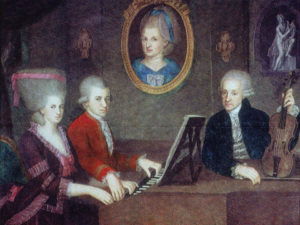Tchaikovsky’s Romeo and Juliet Fantasy Overture is a compelling, deeply personal take on a timeless work of literature. It also provides ample opportunities to explore sonata form and musical expressions of national identity. Check it out, share your comments, and dig even deeper with MITA (learn about MITA here).
Video Transcript
Hi everyone! Valentine’s Day is coming up, and we at ArtsInteractive are going for it this year! I’ve got my hand-written notes for my MITA colleagues, chocolate (that’s for me), and for today’s Blitzlesson we’re going to be looking at the Romeo and Juliet Fantasy Overture by Peter Ilyich Tchaikovsky, who knows a thing or two about being “Romantic.” Let’s get started.
The Drama
First things first, here’s a quick refresher on the story of Shakespeare’s Romeo and Juliet, for those of us who were too busy passing love notes to pay attention in freshman-year English class.
The story is set in Verona, Italy, where the Montague and Capulet families are fighting. Romeo, a Montague, and Juliet, a Capulet, fall in love and secretly get married by Friar Lawrence, who hopes their love will bring peace. But then Romeo, avenging his friend’s death, kills Juliet’s cousin and is exiled. Juliet gets a temporary-coma-inducing potion from Friar Lawrence to fake her own death and then run off to live with Romeo. Friar Lawrence isn’t able to communicate the fake-death thing to Romeo in time, though. Romeo thinks she is actually dead, so he poisons himself next to her body. Juliet wakes up, finds Romeo dead, and then, heartbroken, kills herself with Romeo’s dagger. The story ends with the two devastated families making a late peace.
Ok, maybe it’s not actually the best Valentine’s Day story! But either way, it’s a rich story, and Tchaikovsky does a lot to evoke the drama in the music. He focuses on three important narrative forces: the conflict between the Montagues and Capulets, the love between Romeo and Juliet, and Friar Lawrence’s futile attempts to bridge the chasm. While Tchaikovsky doesn’t specifically mention these dramatic elements, the music’s relationship to them is clear.
A Unique Take on Friar Lawrence
Tchaikovsky first gives us Friar Lawrence, in the overture’s introduction. The somber, elegiac chorale in the winds is doubtless a reference to church music. Let’s hear what that sounds like.
One thing to note about Tchaikovsky’s treatment of Friar Lawrence is that it’s unmistakably Russian, with archaic harmonies and the low register of a Russian male chorus.
Part of the story of this piece itself, composed between 1869 and 1881, is how Tchaikovsky is sorting out his musical identity. On the one hand, there’s this more Western-European conservatory style that he was trained in. On the other, you have “The Five,” a group of Russian-nationalist composers who are criticizing Tchaikovsky for not expressing enough of the “Oriental” elements of Russia’s unique national character.
The Five included famous Russian composer Modest Mussorgsky and was led by Mily Balakirev. Ironically, it was Balakirev who initially suggested that Tchaikovsky write a symphonic poem on Romeo and Juliet, an English play set in Italy. He also is said to have advised Tchaikovsky to follow the sonata form of Beethoven and Brahms. It hardly gets more “Western” than that! In the end, Tchaikovsky uses a pretty straightforward sonata form for Romeo and Juliet, with a few unique touches.
Sonata form, In a Flash
To quickly go over the typical sonata form: it has three essential parts, the exposition, the development, and the recapitulation. Also, an optional introduction and/or coda can go before and after those three parts. The real meat of sonata form is in the exposition. Think “exposition,” like the composer is “exposing” the elements of the piece to you. The exposition can be further broken down into the primary theme (which we hear in the tonic key), the transition (which moves us from the tonic to either the dominant or, if we’re in minor, the relative major key), and finally the secondary theme (which is solidly in the dominant or relative major key). After the exposition, the development flexibly plays on the primary and secondary themes, and the recapitulation essentially repeats the themes, with the key difference that the secondary theme is played in the tonic instead of the dominant or relative major.
Ok, that was a lot of technical stuff! Don’t worry if you didn’t get all of it because I’ll repeat the relevant parts as we come across them. Sonata form is useful in talking about the Romeo and Juliet overture most of all because of how and when Tchaikovsky adapts it to express the drama of the play. Remember that Friar Lawrence theme? That’s actually the introduction in our sonata form. In putting Friar Lawrence first, a departure from the play, Tchaikovsky is emphasizing his importance.
Exposition: Twists to Tell the Story
Primary Theme: Capulets and Montagues
The Capulet-versus-Montague element of the story comes to us by means of the rambunctious and aggressive primary theme. Whereas usually the primary theme firmly establishes us in a key, here, Tchaikovsky quickly shifts between tonal areas, a volatility that suggests conflict and sticks out because it subverts the listener’s expectations about a primary theme. Let’s have a listen:
Remember that after the primary theme, we should expect a key change to get us to the secondary theme, and since the primary theme is in b-minor, we would expect the relative major key of d-major.
Secondary Theme: Romeo and Juliet
It sounds like that’s exactly what we’re gonna get when we end up on a 42-second-long chord that sounds like it’s A-dominant-7, the logical precursor to d-major. But Tchaikovsky tricks us, treating the chord like an augmented-sixth chord of the distant key of d-flat-major, which is where he takes us. Transitioning to this remote key is a clever way of laying out the secondary theme, which evokes Romeo and Juliet in their own little faraway lover-land.
If you can’t quite hear Tchaikovsky’s harmonic tricks in arriving at the secondary theme, don’t worry. Keep working at it – it’ll pay off, I promise; but for now, you can certainly appreciate the romance in the lyrical melody of the English horn and violas and the heartbeat-pulsing of the French horn accompaniment.
One “Russian” element of this theme is the flat-6 on the pre-dominant chord, a favorite device of the Russian Orientalists. It’s that (sings) that resolves.Can we hear that real quick? Oooh yeah, that’s swoon-worthy. So lover-ly is this secondary theme, in fact, that it’s the kissing music from The Sims!
Development Pulls in Opposing Directions
So, now that we’ve gone through the introduction and exposition, you’ve met Friar Lawrence, the Montagues and Capulets, and Romeo and Juliet. The development – remember, the middle section of sonata form – pits our narrative forces against each other. The Montague and Capulet conflict theme sees three challenges from the Friar Lawrence theme, each growing in intensity. But even his final, desperate cry for peace, via the fortissimo trumpets, gets beaten back by the insistent fighting.
A Potent Ending
The second of two codas offers a striking conclusion to the narrative. We get a fragment of the Romeo and Juliet theme – our dying lovers – and then a word from Friar Lawrence that comes off as a benediction this time around. Then we hear minor-mode fragments, repeated, of the Romeo and Juliet theme – our lovers meeting in the afterlife, perhaps? – and finally a glorious, full-orchestra statement of b-major, the direct major key of our b-minor home and conflict theme key, a statement of the transcendent peace that has come out of this terrible tragedy. Let’s listen to just the beginning of that and let it run.
In the end, what Tchaikovsky gives us is a deeply personal take on a timeless work of literature. It took him over ten years to write, as he grappled with Balakirev and The Five’s criticisms concerning his Russianness. Interestingly, recently, I was watching one of my favorite TV shows, The Americans. As some of the Russian characters are trying to educate one of the American characters on what it means to truly be Russian, it’s not Balakirev or Mussorgsky that they play her, but Tchaikovsky. Let him be a reminder that sometimes the most enduring heroes are the ones who speak from their own hearts.
What do you think about Romeo and Juliet, Sonata form, and artistic expressions of national identity? Talk to us in the comments, and don’t forget to like the video and subscribe to our channel for more. See you next time!
Learn More about Tchaikovsky’s Romeo and Juliet
Subscribe to MITA to hear the whole thing and dig deeper.




4 Responses
Stefan Scherer Emunds’ terrific article on Tchaikovsky’s “Romeo and Juliet” interfaces beautifully with Robert Winter’s brilliant MITA introduction to the same work. Readers should remember that as composers of the 19th century sought to broaden audiences unfamiliar with musical procedures, the development of a “program” to assist one’s understanding of an aural phenomenon like music developed a debate among composers about what music by itself could actually accomplish. In responding to a lady fan who had expressed her admiration for one of his “Songs without Words,” asking to be informed about what the words might have been had Mendelssohn chosen to write any, the composer responded that music cannot by itself tell a story. “As things stand, there are no words for the song you like so much, but if there were, I wouldn’t tell you what they were,” he responded. “If I told you that I had written a hunting song, you might not like my music if the thought of chasing innocent foxes on horseback repulsed you, as it does me.” Put another way, the contrasting moods of Tchaikovsky’s “Romeo and Juliet” Fantasy reflect the subject matter of Shakespeare’s tragedy. But, without the words used in MITA, they could not allow a listener to decide, without the words of a program, which conflicted drama of Shakespeare the music reflects.
When at age 15 I applied for a prize in a composition contest of the New York Philharmonic for young composers with a piece called “Two Movements for Oboe and Piano,” I received a letter from the Philharmonic informing me that I could win a prize if I changed the title of my piece to something more attractive. I changed the title to “60 High Street,” asserted that the piece reflected the personality of my oboe teacher, who lived at 60 High Street, and won both a prize and a feature article in the. Boston Globe asserting that I had written a piece of music that ideally captured the personality of my oboe teacher. You can fool some of the people a lot of the time, I learned.
Thank you for sharing your insights and that terrific story, Bob! I agree with your suggestion that the “marketing” decisions that go into a piece of program music cannot be overlooked. I personally enjoy having a good story associated with the music, even if it may be manufactured as in “60 High Street!” But I suppose it’s a matter of taste and execution.
Excellent analysis and video, thank you! It helped me a lot in the preparation of a film on “Romeo and Juliet”.
We are so happy to hear it, Jan. Thank you for watching.